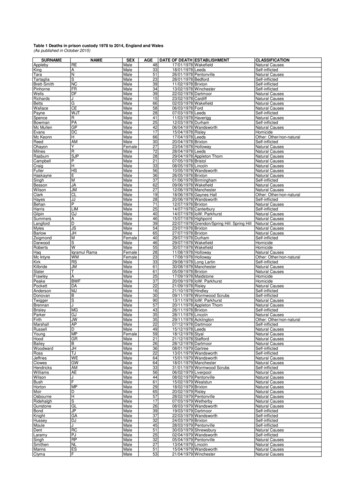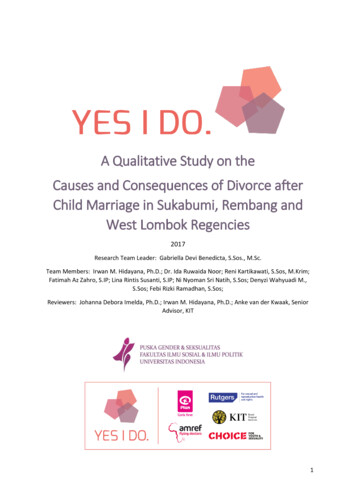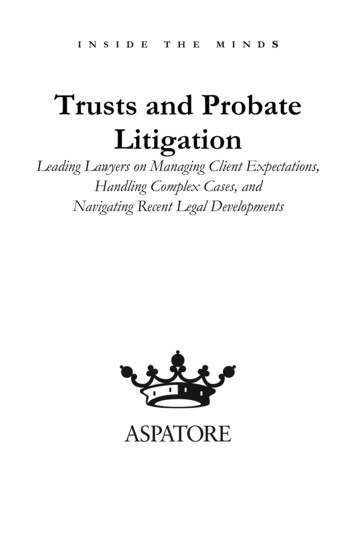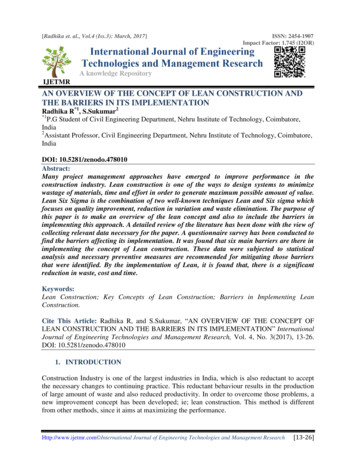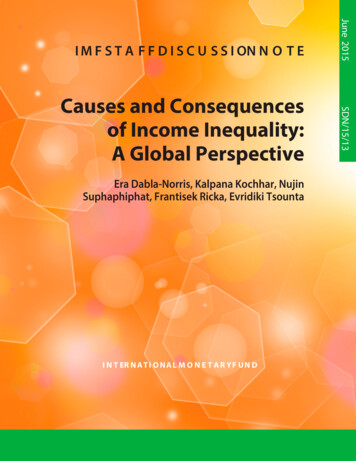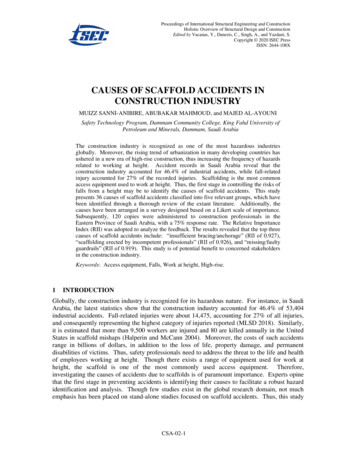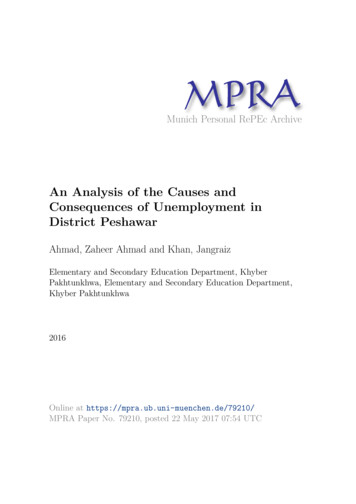
Transcription
Munich Personal RePEc ArchiveAn Analysis of the Causes andConsequences of Unemployment inDistrict PeshawarAhmad, Zaheer Ahmad and Khan, JangraizElementary and Secondary Education Department, KhyberPakhtunkhwa, Elementary and Secondary Education Department,Khyber Pakhtunkhwa2016Online at https://mpra.ub.uni-muenchen.de/79210/MPRA Paper No. 79210, posted 22 May 2017 07:54 UTC
SUIT Journal of Social Sciences and Humanities114Issue.1, December 2016, Vol. 1
SUIT Journal of Social Sciences and HumanitiesIssue.1, December 2016, Vol. 1An Analysis of the Causes and Consequences of Unemployment inDistrict PeshawarZaheer Ahmad 1 and Jangraiz Khan 2Elementary and Secondary Education Department, Khyber PakhtunkhwaAbstractThis paper concentrates on exploring the causes and consequences ofunemployment in district Peshawar. Primary data was collected for this purpose. Theresults show that out of 120 respondents, 32.5% were unemployed due to low education,15.8% due to having no skills &55were unemployed due to no approach to the concernedauthorities. Out of the total respondents65% were unskilled. 73.3% of the respondentshad never joined a job and 18.3% left the job due to low salary. 7.5% were unemployeddue to completion of business / projects.100% of the respondents agreed thatoverpopulation is cause of unemployment. All of 120 respondents agreed with this the factthat unemployment causes suicides and crimes in the society. The causes of high rate ofunemployment are lack of education, lack of capital, lack of proper skill, Poverty, andHigh rate of population growth in Pakistan. It is therefore, recommended on the basis ofthe study to prepare a proper plan for the provision of proper skills, provision of jobopportunities, easy access to credit to motivate people for investment in employmentgenerating activities and eradication of unemployment in the study area.Key Words: Unemployment, Consequences of unemployment, Population, Skills, PovertyIntroductionPakistan is a developing country with a population of 184.35 million (EconomicSurvey of Pakistan, 2012-13). It is facing numerous problems like unemployment,illiteracy, inflation, law and order situation, and internal & external debt. Unemploymentis considered as a major emerging socio- economic problem of Pakistan. Non availabilityZaheer Ahmad 1 and Jangraiz Khan 2115
SUIT Journal of Social Sciences and HumanitiesIssue.1, December 2016, Vol. 1of job opportunity and unwillingness to work at the prevailing wage rate is the majorreason for huge unemployment in the country. It has a crucial effect on socio economicstatus of a nation, and resulted in socio presences like of poverty, corruption, criminalityand depressing rates (Neeleman and Lewis, 1999; Asghar, 2002; Blakely et al. 2003). Ithas negatively affected the physical welfare of the people. Furthermore, it also generatesfeelings like depression, disgrace, hopelessness and bitterness. (Goldney, 1997; Hammarstrom and Janlert 1997).Unemployment is caused by a large number of causal factors. The presentsituation of unemployment, particularly the educated peoples of a country has the gap ofthe founding of valuable jobs and educational organization. In Pakistan, educationstructure is defective and that is the reason for rising population ratio between theyoungest. In our country the youth approach in the direction of his select of a professionare impractical and uncreative. The system lacks educational planning, and, lack oftechnical and vocational institutions. Similarly, Joblessness also increases as a result ofrenovation in the techniques and methods of manufacture. Generally, it may be concludedthat joblessness in a specific period which is the mixture of economic, community andspecific different elements. A person is said to be unemployed if a person has skillfulness,ability and willing to do work but he cannot find the job. In other words, unemployment isdefined as a situation in which citizens of a country have ability and willingly to work butthey cannot get occupations. Unemployment is a situation which a person is skillfully,actively looking for job; however he cannot find some job. The unemployment problemin Pakistan can be broadly classified into rural unemployment and urban unemployment.In rural areas about 68% of the people are living. In Pakistan unemployment is morevisible the areas of rural then urban areas.It is generally observed in rural regions there are less chances of employment as compareto urban the rate of unemployment is more than urban regions. While in urban regions alot of opportunities of jobs because in results of industrial state. In Pakistan the rural116Zaheer Ahmad 1 and Jangraiz Khan 2
Issue.1, December 2016, Vol. 1SUIT Journal of Social Sciences and Humanitiespeople search for industrialized zone for work because there is no suitable source ofincomes. As results the rate of unemployment is rising. Pakistan is agro based country and70 % population are engage with agriculture sector which is not fascinating in the result ofnew instrument and not good circumstances. Rural peoples not finding proper source ofearning. According labor force survey our country is the 9th biggest nationin the world. The total labor was 57.25 million while labor forces 53.84 million areemployed and 3.40 are unemployed (Economic survey of Pakistan,2010-11).All peoplewho are of twelve years and above included in labor force in Pakistan. An institutional andsocio economic system of Pakistan has unsuccessful to make available employment inrising labor force. Unemployment is the most important problem of Pakistan. In Pakistan,the existing condition approximately 35 lack persons remain jobless.Peshawar is the capital of Khyber Pakhtunkhwa. According to District CensusReport (1998), the unemployment rate in Peshawar district is 17.82%, which is high rateof unemployment.For male this rate is very high that is 19.25% as compared to female at nominal rate in of4.80% the unemployment rate in rural parts is 25.09% is compare to urban which is9.10%. According to International Labor Organization, in Pakistan the annual averagerate of labor force growth is estimated to persisting at 3.36%among 2000 and 2014increase 2.3 million new people to labor farce each year. In Pakistan the existingcondition further than 35 lack persons are jobless then proportion of unemploymentremains greater than 12%.Major resources of the state remain scarce, and the populationmore than the peak point. The present study is an attempt to analysis the impacts ofunemployment on socio economic variables in distract Peshawar.Zaheer Ahmad 1 and Jangraiz Khan 2117
SUIT Journal of Social Sciences and HumanitiesIssue.1, December 2016, Vol. 1Review of LiteratureLiterature review is considered as an integral part of any research study. Itprovides basis for nature and sources of data to be used, theoretical framework andtechniques used for analysis. A brief review of the relevant literature is given below.Blaug (1973) discussed in developing country qualified educated persons have to wait forlong time to get a job. There are various factors but corruption is one of the factors whichresponsible for the mismatch between the demands& supply of educated youth. In hisview the stigma of unemployment Raffiet al (1977) carried out a study regarding thenumber of unemployed persons and their job priorities. The study report found that 95%of the unemployed people wished professional, managerial or administrative positions intheir career. According to the results of labour force survey, only 53 percent ofpostgraduates are accommodated in the professions of their choice. The sectorialpreferences seem unrealistic to these professional. Similarly three fourths of unemployedpersons indicate their preference for having government sector jobs. The study shows thatout of 25-years age-group category only 13% worked in the government sector whileothers in private sectors.Khan and Ali (1986) carried out a study regarding lack of career-orientation among theeducated unemployed youth as one of the major reasons of being unemployed.Furthermore, the study found that among the males and females, 15 and 35 % categorizedas poor performers.Pritchard (1995) studied the unemployment situation in England during 1974-90. Thestudy analyzed the situation from age, gender and regional suicide perspective. Thestudy found increased suicides as a result of socioeconomic changes. British male suicideincreased during 1990's as compared to female whose number decreased during the sameperiod, and major cause was unemployment. The study found that poor teenage female118Zaheer Ahmad 1 and Jangraiz Khan 2
Issue.1, December 2016, Vol. 1SUIT Journal of Social Sciences and Humanitiessuicide proportion due to unemployment and also their unsatisfied job opportunities.Rashid (1995) developed another type of model which is presented through openjoblessness and surplus labor. The study found when agriculture employees areindividually efficacy maximize receiving usual products such as incomes, aindustrialized income support may decrease excess (rural) worker however risingexposed (urban) joblessness. The study found that no aid can top the economy in thedirection of completely full employment.Data and Research methodology:Data:The present study is based on primary data. Some necessary secondary data wastaken from different Publications, Economic Journals, articles, and different databases.The population of the present study is district Peshawar. Sample was drawn fromunemployed respondents of Peshawar district.Sample sizeDistrict Peshawar has been divided into four towns. These towns have 92 unioncouncils. The Data was collected from Town II. A sample of 120 respondents was drawnfrom 6 union councils of Town II.Data collection Techniques:The data was collected through a well-designed questioner. The questioner consisted ofall relevant questions which were discussed with experts and pretested.Data AnalysisThe collected data was analyzed by using averages like Mean, graphs, Tables,percentages and appropriate quantitative techniques.Zaheer Ahmad 1 and Jangraiz Khan 2119
SUIT Journal of Social Sciences and HumanitiesIssue.1, December 2016, Vol. 1Results and DiscussionThis chapter consists of results and detailed discussion. The data has beenanalyzed with the help of statistical software SPSS 16.Characteristics of RespondentsDistribution of sample RespondentsThe present study was conducted in district Peshawar and the sample wasdistributed among six (6) union councils of the district. A sample of 20 respondents drawnfrom each of these union councils. The union councils were Kankola, Khazana, Larama,Nahaqi, PakhaGhulam and Takhtabad. The details are given in table 1.Table 1 Distribution of sample in Union CouncilsS.NoUnion CouncilNo of Pakhagh206Takt aba20Total120Age of RespondentsOut of the total 120 respondents 12 being were less than 20 years, 96 were in theage group of 20-40 years .Out of 120 respondents 12 being were in the age group of above40 years.Most of the respondent's i.e.96 Out of 120 being was in the age group of 20-40years.Out of 120 respondents, 92 being were educated while the remaining120Zaheer Ahmad 1 and Jangraiz Khan 2
Issue.1, December 2016, Vol. 1SUIT Journal of Social Sciences and Humanities28respondents being were illiterate.Level of educationFigure 1 Level of educationFigure 1 shows the level of education among respondents. Out of 120 respondents, 28being were illiterate. 36 being were primary to secondary, 33 being were Intermediate,16 being were graduate and7 being were postgraduate.Figure 2 Average monthly family IncomeZaheer Ahmad 1 and Jangraiz Khan 2121
SUIT Journal of Social Sciences and HumanitiesIssue.1, December 2016, Vol. 1Figure 2 shows the average monthly family income of the unemployed persons. Outof 120 respondents, 40 being have less than Rs. 10000 monthly family incomes. And70 out of 120 being have their family income between 10,001- 20,000 while 10 beinghas more than Rs. 20,000.Skill possessed by the Respondents Out of total 120 respondents, 42 means 35% were skilled & 65% wereunskilled.In other words, most of the respondents i.e. 78 were unskilled. It means thatunemployment rate is more in unskilled persons then skilled.Moreover out of the skilledpersons, 7.5% were merchants, 24.2% was driver, 0.8% were cobblers and 2.5% wereothers.Marital Status Out of 120, 59 were married and the remaining respondents 60 being 50% wereunmarried.When they were asked about number of children, according to them, 27 had children inrange of 1-2, 19 15.8% had children in range of 3-4, while 14 respondents had more than 4kids.Were you employed before?When the respondents were asked were they employed before , their responseswere as given below.Out of 120, 32 being 26.7% had employment before, and 88 being 73.3% never got ajob.Reason for leaving previous JobThe previously employed respondents were asked to give reasons for leaving theprevious job. The responses show different reasons. Most of the respondents were never122Zaheer Ahmad 1 and Jangraiz Khan 2
SUIT Journal of Social Sciences and HumanitiesIssue.1, December 2016, Vol. 1employed before. But out of 120 respondents 32 were employed before. 22 respondentssaid that they left the job due to low salary. 9 left the job due to completion of project, and1 due to workers no self-interest.Type of UnemploymentThe table 2 shows the status of unemployment of the respondents. Out of 120, 7were voluntarily unemployed while the remaining 112 were involuntarily unemployed.Out of 120 respondents, 32.5% were unemployed due to low education, 15.8% due tohaving no skills and 45.8% were unemployed due to no access to a job.Table 2 Type of UnemploymentCumulativeFrequencyPercentValid 393.3100.0Total120100.0100.0Valid 0VoluntarilyUnemployment affects social life and causes tensions/frustration.The respondents were asked to record their statement regarding the effects ofunemployment on social life of individuals. Their responses showed that 100 % agreedwith this fact that unemployment affects their social life. Similarly, 100 % respondentsagreed that unemployment if persists for longer period of time, it will lead to frustrationand tension.Zaheer Ahmad 1 and Jangraiz Khan 2123
SUIT Journal of Social Sciences and HumanitiesIssue.1, December 2016, Vol. 1Unemployment affects health.When the respondents were asked about the effects of unemployment onhealth, almost all respondents favoured the statement that unemployment leaves worseeffects on health.Unemployment causes dishonor in societyDue to changing pattern of the society, money is becoming an important factor in socialset up. Unemployed have rare sources of income and are mostly poor. This affects theirstatus in the society. 0.8 % of the respondents disagreed the fact that unemploymentcauses dishonor in society while 1.7 % remained neutral. A great majority of therespondents, 117 supported the statement that unemployment causes dishonor in thesociety.Unemployment affects marital lifeResponse affects maritalFrequencyTable 3: 120100.0The table 3 shows number of persons who are agree and disagree with the fact thatunemployment affects marital life. Out of 120 respondents 119 agreed while 1remained neutral.Unemployment cause increase in Crimes, suicides and drug addictionThe responses of the respondents show that 100% of the respondents agreewith the fact that unemployment causes increases in crimes and suicides. The same124Zaheer Ahmad 1 and Jangraiz Khan 2
SUIT Journal of Social Sciences and HumanitiesIssue.1, December 2016, Vol. 1percentage agree with the fact that it causes drug addiction.Some other effects and causes of unemploymentThe respondents were questioned about their view regarding the effects ofunemployment on some other socio-economic variables. All the respondents agree thefact that overpopulation is the result of unemployment because the unemployed havemore time to spend with their families. The respondents supported the view that one of themajor causes of unemployment is the low level of education. Moreover low skills lead tounemployment as most of the producers or businessmen are in search of highly skilledlabour. Similarly, lack of capital is also a cause of unemployment as most of therespondents agree with the statement that low capital causes unemployment.The study area has fewer industries and that is the reason, the respondents termed lack ofindustries as a cause of unemployment. Due to increasing favoritism in the selectionprocess of different jobs in our society, 100% of the respondents agree with the fact thatapproachable persons are more likely to get a job.When the respondents were asked to whether the Opportunities of employment areincreasing, their responses were different as shown in the figure 3.Figure 3Opportunities of employment are increasingZaheer Ahmad 1 and Jangraiz Khan 2125
SUIT Journal of Social Sciences and HumanitiesIssue.1, December 2016, Vol. 1The figure shows that 93 percent of the respondents disagreed the statement thatemployment opportunities are increasing in the study area. On 3 % favored the statementand 4 % remained neutral.Conclusion This paper focused on finding out, the major causes of unemployment and tounveil socio-economic impacts of unemployment in district Peshawar. Result of thestudy shows that the most important reasons for high rate of unemployment in Peshawarare high rate of population growth, Low level education, poverty, lack of skills, lack ofcapital and favoritism in selection process. Most of the respondents, disagreed thestatement that job opportunities are increasing in the area which means that there is direneed for planning of job opportunities and eradication of unemployment in the area.126Zaheer Ahmad 1 and Jangraiz Khan 2
Issue.1, December 2016, Vol. 1SUIT Journal of Social Sciences and HumanitiesReferencesBlaug, M. (1977). Education and the employment problem in developing countries.Geneva, ILO.Government of Pakistan, Economic Survey of Pakistan (various issues), EconomicAdvisors Wing, Ministry of Finance, Islamabad.Khan, R. S.& Ali.Z. (1986.).Some Findings about the unemployed highly educatedpersons in Pakistan, PIDE, Islamabad, XXV (4).Neeleman J, & Lewis.G.(1999). Suicide religion and socio economic conditions. Journalof Epidemiol Community Health.53,204-21.Raffi, R, Robert E.K. & and Gustafson.W.E., (1977). Idle Brains GraduateUnemployment in Karachi.Applied Economic Research Centre.Research reportNo.11.Rashid. S. &Khanker.A., (1995). Wage subsidy and full employment in a dual economywith open unemployment and surplus labor.Journal of l 18). Educated unemployment in Pakistan” the Pakistan time. 5-10Tendon, D.C. (1986).Economic planning: theory and practice. Chaitanya PublishingHouse,Allahabad, India,pp.82.Zaheer Ahmad 1 and Jangraiz Khan 2127
This paper concentrates on exploring the causes and consequences of unemployment in district Peshawar. Primary data was collected for this purpose. The results show that out of 120 respondents, 32.5% were unemployed due to low education, 15.8% due to having no skills &55were unemployed due to no approach to the concerned authorities.



